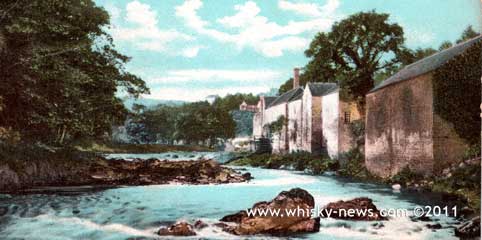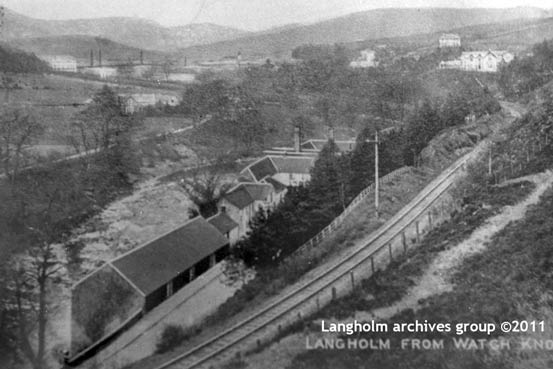

Distillery in Focus: Langholm
Region: Lowlands (Dumfriesshire)
Name: Langholm ( "Long meadow").
Status: Demolished.
Website: n.a.
Telephone: n.a.
E-Mail: n.a.
Address: Skipper's Bridge, Langholm, Dumfries, 55° 08’ 31” N 02° 59’ 18” W
Visitor centre: No.
Owner: n.a.
Established in 1765
Stills: 1 wash and 2 spirit stills
Casks used for maturation: n.a.
Percentage of single malts: n.a.
Contribute(d) to the following blends: mountain dew.
Regular Bottling:
n.a.
 |
| An old coloured photograph of the Langholm distillery (circa 1900). |
 |
| An old photograph of the distillery in 1910. Courtesy of the Langholdm archives group. |
History of the Langholm distillery
Most historical information available about Langholm distillery are coming from Alfred barnard: “
The Distillery is built on a rock which projects into the River Esk and from any point has an extremely picturesque appearance. It is built of solid masonry, and faces the high road, the waters of the river washing by its walls. Since its foundation, in 1765, few alterations have been made in the place, and it p is easy of belief that Whisky was made therein before any of the present generation were born. The establishment has been in the hands of the present, proprietor, Mr. Arthur Connell and his family, for upwards of sixty years, whilst the manager, Mr. Campbell, has been connected with it for more than that period. On entering the Offices we were informed by the manager that there were neither Barns nor Malting Houses to visit, the malt being all supplied by Messrs. Bernard & Co., the eminent maltsters of Haddingtonshire. We first visited the Malt Store, a neat stone building, 50 feet square, situated nearly in the centre of the block, and, although possessing a gloomy interior, is a most suitable place for the purpose.
Underneath is the Mill, which contains a pair of Malt Rollers and machinery driven by water-power. We next inspected the Mashing and Still House combined, forming one building, an old-fashioned place with paved floor, all the vessels being quite in keeping with it. This house contains two heating Coppers for hot water, each holding 1,000 gallons, a Mash Tun, 13 feet in diameter and 5 feet deep, an Underback of similar dimensions, and on the distilling side a Henderson and Turnbull's Refrigerator. Passing through a doorway we came to the Tun Room, which contains several timber Washbacks, and a Wash Charger, holding 8,000 gallons.
Retracing our steps to the Still House, we observed three old Pot Stills, of ancient type, consisting of a Wash Still, holding 1,800 gallons, and two Spirit Stills, containing respectively 586 and 316 gallons. On our way to the Receiver Department we passed a small cooperage and cask shed, and then came to a rocky projection over the river, from whence we had a complete view of the water arrangements in the Distillery, and besides, the view embraced a part of the town of Langholm and the wooded banks of the river opposite, which presented an array of tints and shades in green and brown that would have delighted the heart of a painter, and given him a lesson in colouring not easily forgotten. This department contains a Low-wines and Feints Charger, Spirit Receiver, and Safe. Across the way is the Spirit Store, another quaint building, which has a Vat, of 998 gallons content. Following Mr. Campbell, we proceeded to inspect a few of the twenty Warehouses, which contained at the time of our visit 121,300 gallons of Whisky, dating from 1876.
The three Worm Tubs are built on stone piers over the river, the water being pumped up by a huge water-wheel. The motive power in the Distillery is entirely water, a portion of the river having been diverted through a channel cut out of the solid rock. The water used for brewing purposes is brought from a noted spring in Whitewell Hill, 1.5 miles distant.
The make is pure Malt, and the aged Manager informed us that there is annually made a certain quantity of Birch Whisky, which his father taught him the secret of making. The Malt Whisky is used for blending, being somewhat rich and silent in flavour; it is also sold as a self whisky, and disposed of principally in England. The annual output is 46,000 gallons. “
From other sources, the following information could be extracted:
Due to bad crops, the distillery around 1795, the distillery was converted to a paper mill and distilling was reported in 1818 by John Arnot.
In 1821, the owner was John Arnot & Co, who went bankrupt in between 1825-26. It was bought over in 1827 by the Langholm Distillery Co. and briefly changed its name between 1832 and 1835 to James Kennedy & Co., when his partner John Sibson withdrew. John McConnell took over in 1852 and in 1860 Arthur Connell joined the company.
In 1887, the distillery was registered under the name Langholm Distillery Co., Paterson, W. & J. J., Drove Road. The distillery went out of production in 1917. It was dismantled in 1926 and partially demolished in 1929.
Source: The Whisky Distilleries of the United Kingdom, Alfred Barnard, The Scotch whisky industry record by H. Charles, Craig, The Scotch Whisky Distilleries by Misako Udo, http://www.langholm-online.co.uk/, Wilson's Eskdale and Liddesdale Directory and Almanac for 1887, www.malt-whisky.org.uk, http://www.langholmarchive.org.uk.
Patrick Brossard © 10Jul2011